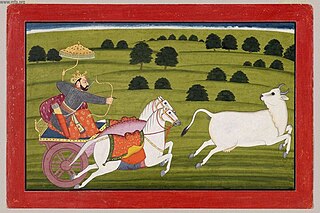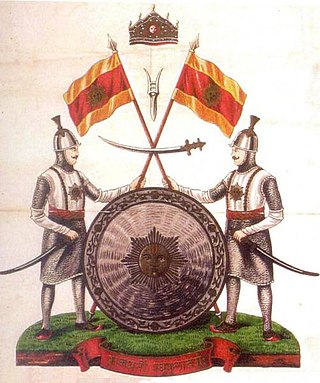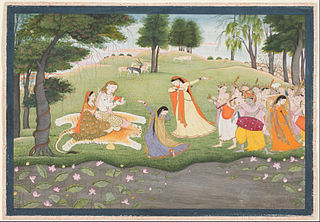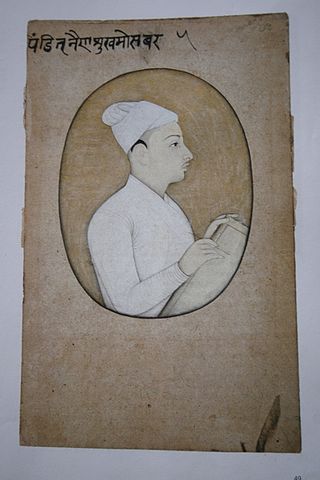
Kangra-Lambagraon was a historical state and later princely estate (jagir) of British India located in the present-day state of Himachal Pradesh.

Rajput painting, painting of the regional Hindu courts during the Mughal era, roughly from the end of the 16th century to the middle of the 19th century. Traditionally, Rajput painting is further divided into Rajasthan and Pahari painting which flourished in two different areas "far apart from each other in terms of distance but all under the rule of Rajput chiefs, and bound together by a common culture".

Pahari painting is an umbrella term used for a form of Indian painting, done mostly in miniature forms, originating from the lower Himalayan hill kingdoms of North India, during the early 17th to mid 19th century, notably Basohli, Mankot, Nurpur, Chamba, Kangra, Guler, Mandi and Garhwal. Nainsukh was a famous master of the mid-18th century, followed by his family workshop for another two generations. The central theme of Pahari painting is depiction of eternal love of the Hindu deities Radha and Krishna. A distinct lyricism, spontaneous rhythm, softness, minute intricate details of composition, and intense perception and portrayal of human emotions and physical features distinguish the Pahari miniatures from the other miniature schools like Deccan, Mughal and Rajasthani-Rajput.
The Hill States of India were princely states lying in the northern border regions of the British Indian Empire. The historic terms Punjab Hills and Pahari Hills were used to describe the foothills of the Western Himalayan-range prior to the independence of India in 1947.

Haripur is a township in Kangra district in the Indian state of Himachal Pradesh. Haripur Guler are twin townships carrying the heritage of Guler Riyasat. A river separates the two towns which further makes Pong wetland, a Ramsar Wetalnd Site, home to a large number of migratory birds in winters because of marshes and the presence of irrigated private land.

The Dogra dynasty of Dogra Rajputs from the Shivalik hills created Jammu and Kashmir through the treaties with the East India Company following the First Anglo-Sikh war. Events led the Sikh Empire to recognise Jammu as a vassal state in 1820, and later the British added Kashmir to Jammu with the Treaty of Amritsar in 1846. The founder of the dynasty, Gulab Singh, was an influential noble in the court of the Sikh emperor Maharaja Ranjit Singh, while his brother Dhian Singh served as the prime minister of the Sikh Empire. Appointed by Ranjit Singh as the hereditary Raja of the Jammu principality, Gulab Singh established his supremacy over all the hill states surrounding the Kashmir Valley. After the First Anglo-Sikh War in 1846, under the terms of the Treaty of Lahore, 1846, the British East India Company acquired Kashmir from the Sikh Empire and transferred it to Gulab Singh, recognising him as an independent Maharaja. Thus, Jammu and Kashmir was established as one of the largest princely states in India, receiving a 21-gun salute for its Maharaja in 1921. It was ruled by Gulab Singh and his descendants until 1947.

Government Museum and Art Gallery, Chandigarh, is a public museum of North India having collections of Gandharan sculptures, sculptures from ancient and medieval India, Pahari and Rajasthani miniature paintings. It owes its existence to the partition of India. Prior to the partition, much of the collections of art objects, paintings and sculptures present here were housed in the Central Museum, Lahore, the then capital of Punjab. The museum has one of the largest collection of Gandharan artefacts in the world.

Kangra painting is the pictorial art of Kangra, named after the Kangra State, a former princely state of Himachal Pradesh, which patronized the art. The art style became prevalent with the fading of the Basohli school of painting in the mid-18th century. Later, Kangra paintings were produced in such magnitude, both in content and volume, that the Pahari painting school came to be known as the Kangra painting school. Kangra painting style was registered under the Geographical Indication of Goods Act, 1999 on 2nd April 2012.

Jaswan was a precolonial Indian state in modern-day Himachal Pradesh, commanded by the Jaswal Rajput clan. It was founded in 1170 AD by Raja Purab Chand, a cadet of the Katoch lineage, ancient royal family of Kangra. Its capital was Rajpura.

Siba State, later known as Dada-Siba, was a small independent Indian hill state in the Lower Himalayas. It was centered on the town of Dadasiba, Pragpur tehsil, Kangra district, in modern-day Himachal Pradesh. The state was founded in ca.1450. In 1849 the territory of Datarpur was added to Siba Jagir and annexed by the British Raj as 'Dada-Siba'.

Nainsukh was an Indian painter. He was the younger son of the painter Pandit Seu and, like his older brother Manaku of Guler, was an important practitioner of Pahari painting, and has been called "one of the most original and brilliant of Indian painters".

Brijinder Nath Goswamy was an Indian art critic, art historian, and vice chairman of the Sarabhai Foundation of Ahmedabad, which runs the Calico Museum of Textiles. Goswamy was best known for his scholarship on Pahari painting and Indian miniature paintings. He was the author of over 20 books on arts and culture, including Sakti Burman: A Private Universe, a monograph on the life and works of Sakti Burman, renowned Bengali painter and Masters of Indian Painting 1100-1900, a treatise on Indian miniature art. The Government of India awarded him the fourth highest civilian award of the Padma Shri in 1998 and followed it up with the third highest honour of the Padma Bhushan in 2008.
The Battle of Guler was fought between forces led by Sikh Guru Gobind Singh and Mughal forces, aided by the Rajas of the Sivalik Hills.

Manaku of Guler or Manaku was an Indian painter from the Guler State, in modern-day Himachal Pradesh. After his death he was mostly forgotten and overshadowed by his much-celebrated younger brother Nainsukh. But today he is recognised as an exponent of Pahari style of painting, much like his brother. The rediscovery of Manaku has been a result of research efforts by art historians like B. N. Goswamy. Like Nainsukh, Manaku almost never signed his works, and only four extant works carry his signature.

The Hill States–Sikh wars, also known as the Sikh–Pahari Raja wars, was a set of battles and conflicts fought by the Sikhs and the rajas (kings) of the Hill States located in the Sivalik Hills.

Sikh painting is a form of Sikh art style spread from Punjab Hills to the Punjab Plains which flourished between the 18th to 19th centuries. Major centres for the art school was Lahore, Amritsar, Patiala, Nabha, Kapurthala and Jind. Artists from surrounding regions migrated to Punjab seeking patronage for varying reasons. Most depicted scenes in Sikh painting are of Sikh gurus, portrait of chiefs of the states and court scenes. In the later period the artists painted popular traders of bazaar, such as cobbler carpenter, blacksmith etc. Considering the geographic boundaries were changing frequently in that period and the artists were generally migrants, there is always an overlap between Pahari styles such as Kangra and Guler with the Sikh style.
Indian miniature paintings are a class of paintings originating from India. Made on canvases a few inches in length and width, the Indian miniatures are noted for the amount of details that the artist encapsulates within the minute canvas frame; and the characteristic sensitivity with which the human, divine and natural forms are portrayed.
SheikhBasharat Ullah (1801–1892), also known as Basahathullah or Basahatullah, was a Punjabi miniature painter who was employed as a court-painter for various states, such as Patiala State.

Purkhu, also spelt as Purkhoo or Parkhu, and also known as Purkhu of Kangra, was a Pahari painter who specialized in the Kangra-style. He painted both courtly and religious themes.

Seu, also known as Pandit Seu, was a Pahari artist who specialized in musawir. He was attached to the court of Raja Dilip Singh of Guler State.


















